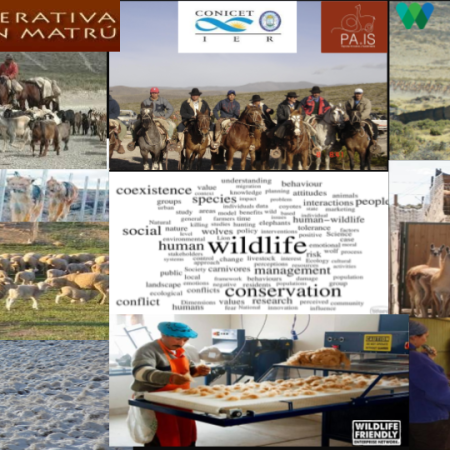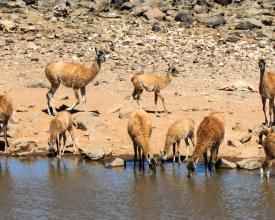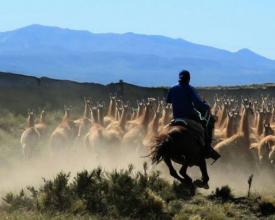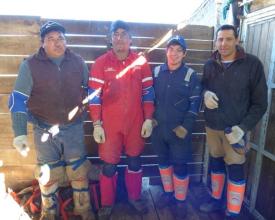
Fibre patagonienne respectueuse de la faune : Renforcer les capacités pour une utilisation durable du guanaco.

"Nous devons réfléchir à des actions respectueuses de la faune et de la flore".
L'objectif de cette solution est de souligner et d'étendre l'importance de l'utilisation durable de la fibre de guanaco en raison du potentiel de cette activité à générer un développement socio-économique local et à devenir un outil de conservation efficace réduisant l'impact de l'empreinte humaine. Pour y parvenir, nous proposons de 1) promouvoir l'utilisation durable des populations de guanacos sauvages à travers des expériences démonstratives de tonte à vif dans la réserve de La Payunia ; 2) encourager la création d'une chaîne qui augmente la valeur commerciale de la fibre de guanaco en reliant les secteurs de production primaire au secteur textile national et international ; 3) générer des certifications WFA qui augmentent la valeur marchande de la fibre, et 4) encourager les actions de la WFA à travers des stratégies de communication efficaces qui donnent de la visibilité à la gestion durable des guanacos sauvages. "Nous croyons au pouvoir des consommateurs pour changer les paradigmes de l'utilisation des terres.
Contexte
Défis à relever
100 ans d'élevage de moutons en Patagonie ont conduit à une intolérance de l'homme à l'égard des guanacos, qui, combinée à la chasse illégale, a décimé les populations d'animaux sauvages dans les zones protégées. Notre projet a atteint les objectifs suivants : 1) conservation de la biodiversité, en augmentant l'abondance et la viabilité de l'une des rares populations existantes qui continuent à effectuer des migrations annuelles sur de longues distances, en rétablissant leur rôle fonctionnel et en changeant la perception négative des populations locales en une perception positive ; 2) gestion des terres, en réduisant le processus de désertification et en améliorant les conditions de vie des populations locales. 2) Gestion des terres, en réduisant le processus de désertification de l'écosystème aride en raison d'une mauvaise gestion du bétail et d'une densité supérieure à la capacité de charge de l'aire de répartition. 3) Solution sociale, en construisant un centre textile unique dans la région (à l'intérieur de la Payunia), en générant de la main d'œuvre locale et en évitant l'émigration des jeunes vers les centres urbains.
Emplacement
Traiter
Résumé du processus
Les quatre blocs (B1, B2, B3, B4) doivent fonctionner dans une relation "ascendante", la première étape (et la plus importante) étant l'obtention de la matière première, la laine. Les lignes orange sont les premières étapes à réaliser en B1, les lignes vertes sont les étapes à réaliser en B2, les lignes jaunes sont les étapes à réaliser en B3 (nous devons répondre aux exigences de durabilité sociale et écologique de la WFEN, à la viabilité de la population des espèces gérées).
Blocs de construction
Promouvoir l'utilisation durable des populations de guanacos sauvages par le biais d'expériences démonstratives de tonte en direct à La Payunia.
La tonte annuelle des guanacos par la coopérative Payún Matrú est étroitement surveillée par le département des ressources naturelles renouvelables de Mendoza afin de s'assurer que le revenu économique potentiel fourni par la laine de guanaco est réalisable et durable. En même temps, les membres de la coopérative comprennent qu'en adoptant de "bonnes pratiques", ils reçoivent de "bons avantages". Le CONICET a testé et développé des méthodes pour minimiser le stress des guanacos individuels pendant la capture et la manipulation, ce qui réduit les impacts négatifs au niveau de la population. Notre connaissance des processus écologiques, physiologiques et comportementaux qui "contraignent" ces camélidés à La Payunia, basée sur plus de 10 ans d'études, nous place dans une position unique pour conseiller et enseigner à la coopérative et aux parties prenantes du gouvernement comment minimiser les impacts de la tonte à vif sur cette population. Nous continuerons à former les membres de la coopérative Payún Matrú aux "bonnes pratiques" pour que la capture et la tonte des guanacos sauvages s'inscrivent dans le cadre des actions "Wildlife Friendly". Les activités suivantes seront menées à ce stade :
Facteurs favorables
1) Enquêtes préalables à la tonte sur les paramètres de la population, 2) La formation du personnel (sans expérience) chargé de la manipulation des guanacos pendant l'élevage, dans les corrals et pendant la tonte est la clé de la réussite des activités. 3) Gestion des guanacos sauvages : La capture, la tonte et le relâchement des guanacos sauvages seront effectués en deux fois, entre septembre et novembre. 4) Indicateurs physiologiques : stress physiologique en fonction des conditions de manipulation. 5) Enquêtes après la tonte sur les paramètres de la population tels que la structure sociale et la densité de la population.
Leçon apprise
-Comme nous travaillons avec des animaux sauvages, les études préalables à la tonte sur les paramètres de la population nous aident à sélectionner la meilleure zone pour construire la structure de gestion.
-La formation du personnel est fondamentale (et la clé du succès de cette solution) pour une bonne gestion des animaux, en évitant la mortalité des guanacos et les blessures des opérateurs. La gestion des guanacos sauvages est différente de celle de tout autre animal domestique, et il est nécessaire d'utiliser des structures et des outils particuliers, ainsi que d'apprendre des manœuvres spécifiques pour leur manipulation, tout en gardant à l'esprit le bien-être de l'animal.
-L'approche du stress nous donne un indicateur physiologique clé pour réduire le stress en fonction du temps de manipulation.
-Les études réalisées après la tonte nous fournissent des paramètres clés de la population, tels que la structure sociale et la population, ce qui nous permet de comparer les données avec celles obtenues avant la tonte et de définir l'impact sur les perturbations sociales.
Encourager la création d'une chaîne qui augmente la valeur commerciale de la fibre de guanaco en reliant les secteurs de production primaire aux secteurs textiles nationaux et internationaux.
Travailler avec différents acteurs aux niveaux local, national et international, afin de contribuer à la conception d'une chaîne de valeur de la fibre qui puisse déclencher l'activité. Le travail consistera à identifier les principaux acteurs publics et privés afin de fournir des outils pour la commercialisation du produit. Les activités qui seront développées à ce stade du projet comprennent des réunions avec le secteur textile, les autorités chargées de l'application et divers acteurs locaux importants dans ce domaine.
Facteurs favorables
-Réunions avec des représentants d'organisations nationales pour évaluer le contexte, les réglementations, le marketing et les possibilités de soutien pour les expériences de gestion des guanacos sauvages.
-Réunions avec des créateurs de mode sélectionnés à l'échelle nationale (Buenos Aires) ou internationale (Canada), afin de créer une chaîne de valeur équitable et de promouvoir l'expérience du WFA.
-Des options à valeur ajoutée seront identifiées au niveau national/international lors de réunions avec des acteurs des secteurs public et privé, afin d'étendre la WFA en tant que "solution basée sur la nature".
Leçon apprise
Les actions de gestion des camélidés sauvages ont débuté dans les années 80, sur la base de la philosophie des "ICDP", cherchant à lier la conservation de la biodiversité à l'amélioration de la qualité de vie des populations locales. Ces projets, qui se sont d'abord concentrés sur la vigogne, étaient basés sur l'application d'incitations économiques pour promouvoir l'utilisation de la faune sauvage. Nous prouvons que l'utilisation du guanaco sauvage pourrait améliorer les chiffres de ces initiatives en raison de la plus grande aire de distribution de l'espèce. En Argentine, la production de fibre SAC pourrait facilement doubler en raison de l'augmentation du nombre de populations tondues et de l'augmentation de la fréquence de la tonte. Cela conduirait clairement à un changement du paradigme de production par rapport au paradigme actuel. La fibre de guanaco est parmi. La coopérative a décidé d'ajouter de la valeur à la fibre brute afin d'en augmenter la valeur. En 2010, la plupart des projets ont été arrêtés en raison de la difficulté à commercialiser la fibre de guanaco à un prix de 40 à 60 USD par kilo. Le "problème" est qu'il n'y a que deux sociétés commerciales qui achètent la fibre brute exportée principalement vers l'Italie et qui contrôlent les prix du marché.
Générer des certifications respectueuses de la faune et de la flore qui augmentent la valeur marchande de la fibre.
La province de Mendoza possède ce que nous considérons actuellement comme le projet de tonte de guanacos le plus respectueux de la faune sauvage, qui est en cours depuis dix ans. En raison du type de gestion mis en œuvre à La Payunia, il est possible que les produits soient certifiés "Wildlife Friendly". Le réseau Wildlife Friendly Enterprise Network (WFEN) est une communauté mondiale qui se consacre au développement et à la commercialisation de produits qui préservent les espèces sauvages menacées tout en contribuant à la vitalité économique des communautés rurales. Le réseau établit la norme mondiale pour la vente de produits "verts" et aide ses membres à atteindre des marchés nouveaux et dynamiques. La mission du WFEN est de protéger les espèces sauvages en certifiant les entreprises qui garantissent la coexistence et l'épanouissement de l'homme et de la nature. La certification de la WFEN vise à promouvoir la conservation des espèces sauvages en facilitant les pratiques de production responsables, le développement des entreprises, l'éducation et l'image de marque. Elle permettra également d'accéder à des marchés nouveaux et dynamiques et d'obtenir un prix équitable pour les produits respectueux de la faune et de la flore sauvages.
Facteurs favorables
Tout d'abord, un candidat doit soumettre le formulaire de pré-évaluation des produits mondiaux de la WF et le formulaire de référence pour demander la certification. Le formulaire de pré-évaluation fournit des informations sur les producteurs, leurs produits et les conditions de conservation de la faune sauvage dans leur région afin de comprendre si les produits peuvent répondre aux critères de mission du WFEN. Le formulaire de référence doit être rempli par un membre d'une organisation de protection de la nature qui connaît bien le programme et son contexte de protection de la nature. Des frais non remboursables de 250 $ doivent accompagner la pré-évaluation et le formulaire de référence.
Leçon apprise
Fondée sur les principes de la conservation de la faune et de la flore, du bien-être économique et de la responsabilité, chacune de nos lignes de produits certifiés illustre les possibilités d'un triple succès pour les personnes, la planète et le profit.
Un lien direct entre la production et la conservation est essentiel pour la certification par le réseau. Les produits qui reversent un pourcentage de leurs bénéfices à la conservation mais qui ne réduisent pas les menaces pesant sur les espèces clés ne sont pas certifiés par le WFEN. Pour que les communautés vivant avec la faune sauvage adoptent des pratiques de conservation, les avantages associés doivent être tangibles et significatifs. Les produits certifiés doivent contribuer à l'augmentation des revenus locaux et/ou à l'amélioration des moyens de subsistance. La mission de conservation du produit comprend un mécanisme d'application clair, de sorte que le non-respect des mesures de conservation requises entraîne des conséquences immédiates, y compris la perte de toute récompense économique. L'incapacité à apporter des corrections substantielles dans un délai raisonnable entraînera la suspension du réseau, y compris la perte de la certification et de la fourniture d'informations aux vendeurs et distributeurs.
Favoriser le fait que les actions favorables à la faune (c'est-à-dire l'utilisation des guanacos) pourraient apporter des solutions au conflit généré entre le paradigme de la conservation et celui de la production de bétail.
La communication est vitale pour toute entreprise, tout commerce ou toute activité professionnelle. Il est inutile d'avoir beaucoup de connaissances et de grandes capacités à générer un bon produit si nous ne parvenons pas à nous rendre visibles d'une manière efficace, en attirant les consommateurs. Pour les grandes entreprises (qui disposent d'un budget et d'une affectation spécifique), il est relativement facile de trouver l'idée parfaite et de façonner la campagne. Stratégies SEO, SEM, questions d'utilisabilité et d'UX, médias sociaux, mise en œuvre de canaux tels que le marketing par courriel ou par SMS, etc. Une bonne campagne sait comment faire de la place dans tous ces domaines. Cependant, c'est une erreur de penser que seules les entreprises disposant de ressources importantes peuvent obtenir une bonne présence numérique ou en dehors de celle-ci. Lorsque nous parlons de "communication sociale", nous devons garder à l'esprit que tout le monde n'a pas accès à chacune des plateformes numériques disponibles et que les entreprises ne sont pas présentes dans tous les réseaux sociaux existants. Nous considérons qu'une stratégie est "réussie" si nous parvenons à gagner en visibilité en utilisant les canaux de communication les plus fréquents pour susciter l'intérêt et la fidélité.
Facteurs favorables
"créer, mesurer et apprendre" des stratégies de communication potentielles sur le WFA. Ces ateliers expliqueront les lignes directrices de base sur les styles de communication, les impacts des différentes stratégies et l'échelle de celles-ci. Certaines campagnes voudront gagner en visibilité, en notoriété, générer un engagement dans les réseaux sociaux ou simplement avoir un impact considérable pour faire agir le public. Formation aux actions de communication afin de développer et de renforcer les capacités des parties prenantes nationales et des communautés locales à développer le WFA.
Leçon apprise
Les membres de la coopérative Payún-Matrú pourraient à l'avenir enseigner les méthodes qu'ils ont apprises au cours de ce projet à d'autres groupes qui souhaitent gérer les guanacos en Patagonie. Les actions respectueuses de la faune pour obtenir de la fibre de guanaco deviennent une procédure standard pour les producteurs de fibre de guanaco tout autour de la steppe patagonienne.
Les efforts de communication déployés jusqu'à présent, par le biais de petites notes sur des pages scientifiques, à la télévision et à la radio, pour diffuser notre projet ont porté leurs fruits. L'une d'entre elles a atteint les responsables de Good Growth, l'entreprise internationale qui met en relation la science, les clients et les marques les plus prospères du monde.Avec l'aide de WCS, qui est un représentant de la WFEN et qui, à ce titre, sert de lien entre les deux entreprises, un contrat a été signé, qui stipule deux points importants : a) les parties comprennent que les coûts d'une opération de gestion bien menée impliquent que le prix de base de la fibre brute de guanaco soit de 200 dollars ; b) l'achat de 100 kilos auprès de la coopérative Payun Matru.
Impacts
"Conservation de la biodiversité et problème de gestion des terres"
L'un des problèmes les plus épineux et les plus controversés de l'Amérique du Sud est de savoir quelle est la "meilleure façon" de gérer les terres publiques établies pour des usages multiples tels que l'extraction des ressources naturelles, la faune et la flore, et les loisirs. Dans la Patagonie aride, plus de 95 % des terres appartiennent à des propriétaires privés et, pour la plupart, ont été converties à l'élevage de moutons, ce qui a entraîné une grave désertification des habitats et le déclin d'espèces sauvages telles que le guanaco. L'élevage étant devenu moins rentable au cours des dernières décennies, de nombreuses personnes sont à la recherche d'alternatives économiques.
"Impacts de la solution WFA sur la conservation de la biodiversité et la gestion des terres"
Une communauté auto-organisée en coopérative ("Payun Matru") de personnes vivant autour de la réserve de La Payunia a procédé à la tonte de guanacos pour récolter leur précieuse laine. Nous considérons que l'utilisation de camélidés sauvages (notre faune) aurait un rôle fondamental dans la réduction du processus de désertification des écosystèmes arides (solution de l'aire protégée), en fournissant une alternative économique (ajoutée à la valeur commerciale élevée de la fibre de guanaco sur le marché extérieur) pour les producteurs locaux (solution sociale) et en augmentant la rentabilité de la terre. Nous changeons le conflit par la COEXISTENCE
Bénéficiaires
Une communauté (plus de 60 familles) s'est organisée en coopérative - "Payun Matru". Ce prix permettra de former des formateurs du WFA avec les membres de la coopérative, de consolider l'expérience dans la région et d'étendre le WFA à d'autres provinces (Chubut, Santa Cruz).
Objectifs de développement durable
Histoire

"Le conflit
L'un des problèmes les plus épineux et les plus polarisants de l'Amérique du Sud est de savoir quelle est la "meilleure façon" de gérer les terres publiques établies pour des usages multiples tels que l'extraction des ressources naturelles, la faune et la flore, et les loisirs. Dans la Patagonie aride, plus de 95 % des terres appartiennent à des propriétaires privés et, pour la plupart, ont été converties à l'élevage de moutons, ce qui a entraîné une intolérance à l'égard des guanacos dans ces régions, et la chasse illégale a décimé les populations. La migration des guanacos est un phénomène écologique menacé qui ne persiste que dans quelques populations (par exemple à Payunia).
Dans les zones rurales de Patagonie, il existe encore des éleveurs transhumants qui parcourent les routes traditionnelles avec leurs troupeaux sur une distance pouvant aller jusqu'à 200 km entre les zones d'alimentation d'hiver et d'été, accompagnés de leurs familles et parfois même de l'instituteur des enfants. Le bétail est élevé à des densités supérieures à la capacité de charge de l'aire de répartition et les troupeaux sont mal gérés, ce qui accroît les interactions concurrentielles avec la faune sauvage (par exemple les guanacos) et rend le bétail plus vulnérable aux maladies qui peuvent être transmises à la faune sauvage indigène. Il en résulte une mauvaise condition du bétail, des décennies de surpâturage (des prairies de la steppe patagonienne) et un climat de plus en plus sec qui ont rendu plus difficile la survie des bergers et la solvabilité des éleveurs, menaçant ainsi leurs moyens de subsistance et leur culture.
"La solution
Les éleveurs locaux ont besoin d'une alternative pour mieux vivre en réduisant le nombre de chèvres et de moutons. Cela permettra à l'habitat de se reconstituer et de réduire la concurrence et les conflits avec les animaux sauvages. Le guanaco est le plus répandu des camélidés d'Amérique du Sud, allant de la Patagonie au Pérou en passant par l'ouest de l'Argentine. La laine de Payún est produite par la coopérative auto-organisée "Payún Matrú", composée d'éleveurs, dont beaucoup appartiennent à des familles qui produisent de la laine de chèvre depuis 50 à 100 ans à La Payunia, une zone protégée de 6 641 km2 dans le nord de la Patagonie. La particularité de la Payunia repose sur son aspect volcanique, ses paysages, ses reliefs, logiquement en relation avec la faune (plus de 25 000 guanacos), la flore unique (district phytogéographique "La Payunia") et les aspects culturels de la région. Nous nous concentrons sur cette solution souhaitable, afin d'obtenir la certification de la fibre de Payun par l'association Wildlife Friendly®. Les éleveurs s'engagent à gérer leur bétail en coexistence avec les guanacos de manière durable. Ces fibres fines contribuent à préserver l'habitat de la faune sauvage, des moyens de subsistance durables et un mode de vie.

















